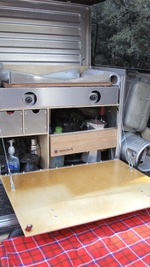Tested: Kanz Field Kitchen
by Roseann Hanson
When I was little my family had a chuck box for camping. Most of our camping was with the Boy Scouts, for whom my father was a Scoutmaster. His name is Charles, and friends called him Chuck, so I always thought it was his box, spelled with capital letters, as in “Chuck's Box.”
My mind and heart store so many indelible memories associated with that old beat up box . . . cold nights in pine forests (a treat for a desert kid), smoky fires, charred marshmallows, howling coyotes (we pretended they were wolves), tales of the Lost Dutchman Mine in the Superstition Wilderness, and mom serving forth from the chuck box innumerable stews and casseroles, invariably containing Cream of Mushroom Soup. High dining for an 8-year-old.
Fast-forward to 1987: in our third year of married bliss, knowing how much I loved the old family box, Jonathan built me a wooden chuck box, varnished as lovingly as an Alden schooner. It had a piano-hinged drop-down front, cork lining, silverware drawer, plate slots, shelves, and a secret panel along the back of the drawer, with a row of cutout leaping dolphins. Used on our first and subsequently countless trips to Baja and Sonora, throughout the American West and even the Arctic—first in my ‘78 JF55 and then in several Toyota pickups—it logged 75,000 miles+ of exploration.
Alas, it was retired when we upscaled to a Four Wheel Camper in the late 1990s. But lately, I had been missing my old chuck box (which is retired to a place of honor in storage, with our original Sigg cook set and brass Svea stove). I'm back to camping out of a classic Land Cruiser, so when I had a chance to test out the Kanz Field Kitchen, I jumped at it.
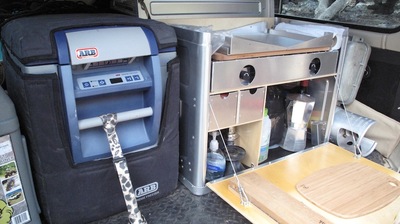 I was intimidated at first. Fully half again as large as my old box, the 19" x 25" x 15" Kanz is gleaming burnished aluminum with beautiful satin-finished Baltic birch. I could lift and carry the old box, but the Kanz takes two of us. This is because it is a kitchen, not just a chuck box; included with our kit is the 22" Partner Steel stove and Kanz's own complete cookware / utensil set. The box + stove is 36 pounds (40 with the Coleman dual-fuel), and 52 with cookware etc. (Kanz's set includes a top-line Snow Peak cookset, Kanz' own double-wall mugs, a percolator, enamelware, and flatware).
I was intimidated at first. Fully half again as large as my old box, the 19" x 25" x 15" Kanz is gleaming burnished aluminum with beautiful satin-finished Baltic birch. I could lift and carry the old box, but the Kanz takes two of us. This is because it is a kitchen, not just a chuck box; included with our kit is the 22" Partner Steel stove and Kanz's own complete cookware / utensil set. The box + stove is 36 pounds (40 with the Coleman dual-fuel), and 52 with cookware etc. (Kanz's set includes a top-line Snow Peak cookset, Kanz' own double-wall mugs, a percolator, enamelware, and flatware).
It is hard to come up with any engineering complaints about this kitchen. Designed over a 12-year period by industrial designer Harald Kanz, the kitchen is the embodiment of German meticulousness for detail and quality. As a young boy, Harald's imagination was captivated by stories of adventure and exploration, he’s said. Fascinated by how things work in the outdoors, he sketched his first tent designs and fire setups while on camping trips with his parents in Germany.
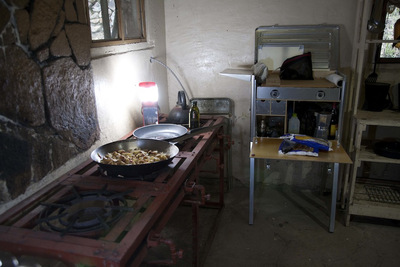 On a recent science expedition to the Sierra Madre in Mexico, we used the Kanz Field Kitchen to augment the very rudimentary kitchen at the old camp.The Kanz Kitchen’s easily detachable legs (fitted with clever pressure springs that you don’t have to fuss with, they just slide in and out easily but hold tight when they need to) perch the kitchen’s top surface at optimal working height (37"); the lid acts as windscreen, can be laid flat as a shelf (with optional hardware), or can detach as serving tray. A custom cutting board fits into the Partner stove, and the 2 drawers, which look deceptively small, swallow all necessary utensils plus 4 double-walled mugs (and, I found out happily, my Sea to Summit folding bucket). There is a 2" hole for the propane line right where it needs to be (with an included cap, which we’ve needed to seal up the kitchen against mice), and the whole unit can be ordered as
On a recent science expedition to the Sierra Madre in Mexico, we used the Kanz Field Kitchen to augment the very rudimentary kitchen at the old camp.The Kanz Kitchen’s easily detachable legs (fitted with clever pressure springs that you don’t have to fuss with, they just slide in and out easily but hold tight when they need to) perch the kitchen’s top surface at optimal working height (37"); the lid acts as windscreen, can be laid flat as a shelf (with optional hardware), or can detach as serving tray. A custom cutting board fits into the Partner stove, and the 2 drawers, which look deceptively small, swallow all necessary utensils plus 4 double-walled mugs (and, I found out happily, my Sea to Summit folding bucket). There is a 2" hole for the propane line right where it needs to be (with an included cap, which we’ve needed to seal up the kitchen against mice), and the whole unit can be ordered as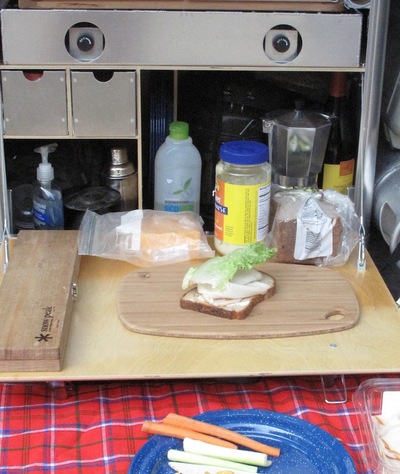 The drawers swallow all our utensils, coffee mugs, and even a folding Sea to Summit bucket. A full-sized cook kit from Snow Peak, an espresso maker, bottle of wine, dish soap, six plates, a full set of spices, coffee making filter, and martini shaker round out the kit, with room to spare. an optional certified-bear-safe unit. The 2 side shelves which are optional are very handy.
The drawers swallow all our utensils, coffee mugs, and even a folding Sea to Summit bucket. A full-sized cook kit from Snow Peak, an espresso maker, bottle of wine, dish soap, six plates, a full set of spices, coffee making filter, and martini shaker round out the kit, with room to spare. an optional certified-bear-safe unit. The 2 side shelves which are optional are very handy.
The only thing I found curiously lacking was a paper towel holder. A simple holder that would hang under a side shelf would be great. In keeping with Kanz’ environmentally aware design, perhaps this is by design—a gentle reminder I should be using washable towels instead, but I hate smelly kitchen towels when on camping trips.
I used the kitchen out of the back of the Land Cruiser, facing outwards, for fixing lunch on a recent science expedition into the Sierra Madre backcountry in Mexico. Sitting next to the ARB fridge, the top area was very convenient for setting things when they came out of the fridge, and the fold-down work surface perfect for making sandwiches.
For our camp, it’s easier to pull the kitchen out and use it on its legs, rather than on the tailgate. I like the longer legs, but the height of the stove makes it little harder to use big pots; it’s an adjustment to the usual tailgate-height or height of your at-home stove, but it’s do-able considering the convenience. We use the stove with our aluminum propane cylinder, the same one Kanz sells (he actually got the idea from Jonathan’s article on propane systems in Overland Journal). I have yet to put a mount into the back of my Land Cruiser for the cylinder, but I plan to (Kanz also sells this . . .).
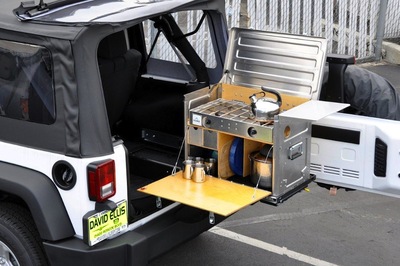 On Tembo Tusk's side-out slide.The Kanz Field Kitchen is large enough that, with the ARB fridge in the back of the Land Cruiser, it fills the back, with no room for our nice stainless steel water tank (we had to resort to using the Rhino plastic jug, the horror!). For ultimate convenience we are working on a layout that would allow us to mount the water tank as well as the fridge and Kanz Field Kitchen on pull-out runners, but we haven’t quite sorted it out.
On Tembo Tusk's side-out slide.The Kanz Field Kitchen is large enough that, with the ARB fridge in the back of the Land Cruiser, it fills the back, with no room for our nice stainless steel water tank (we had to resort to using the Rhino plastic jug, the horror!). For ultimate convenience we are working on a layout that would allow us to mount the water tank as well as the fridge and Kanz Field Kitchen on pull-out runners, but we haven’t quite sorted it out.
Kanz does sell Tembo Tusk's superb quality sliders (side-out or front-out) for the Field Kitchen. Though expensive and heavy, they are the best available and really add to the utility of the kitchen. 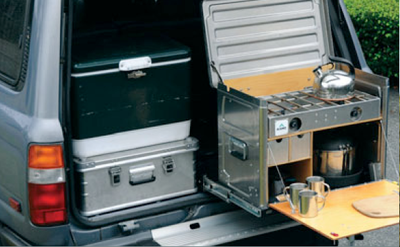 On Tembo Tusk's front-out slide.
On Tembo Tusk's front-out slide.
Kanz accessories include a matching pantry box and a bridge / work surface that joins the two. Thinking of everything (so German!), Kanz also sells wall mounts, a soft cover for transit-protection, and leather straps for horse outfitters.
They also sell my favorite food boxes: Zarges K470 aluminum cases (in photo at left, under the cooler), which are light and stack nicely. I currently use one for my own pantry, with a collapsible metal stand (an old Coleman stove stand), and it matches the Kanz Field Kitchen nicely.
I was ready to find the Kanz Kitchen lacking in comparison to my old dear ones, if only out of loyalty, but I could not: it’s a new classic, ready to fill the old shoes with honor. The price is, of course, daunting, and could be off-putting for some. But with absolute top-quality, made-in-America workmanship, exceptional materials, fit, and finish, it is worth every penny. A field kitchen is, after all, more than just a place to store your kitchen gear. With time and use, it will store many wonderful memories, of good times and beautiful places with special friends.
Specifications, Kanz Field Kitchen:
Outside Dimensions (H x W x D): 19.4 in x 25.4 in x 15.00 in, (492 mm x 645 mm x 381 mm)
Inside Dimensions of stove compartment (H x W x D): 6.3 in x 24.8 in x 14.0 in, (160 mm x 630 mm x 355 mm)
Inside Dimensions of silver ware drawer (H x W x D): 4.0 in x 3.8 in x 13.9 in, (100 mm x 97 mm x 353 mm)
Group size + guest: 6+2
Weight (empty): 25 lbs (12 kg)
Weight (with Partner Steel propane stove): 36 lbs (16.3 kg)
Weight (with Coleman 414 dual fuel stove): 40 lbs (18.1 kg)
Weight of optional cookware set): 16 lbs (7.3 kg)
Table top height (on long leg set): 26 in (660 mm)
Counter top height (long leg ; short leg set): 43 in (109 mm); 37 in (940 mm)
Transport: One foldable sprung handle on each side with rubber grip
Material: Baltic birch plywood riveted to marine grade aluminum panels
Finish: Polyurethane clear coat on wood panels inside and outside
Price without stove or cooking set: $595
Price as tested (with Partner Steel Stove and complete cooking set): $1399

